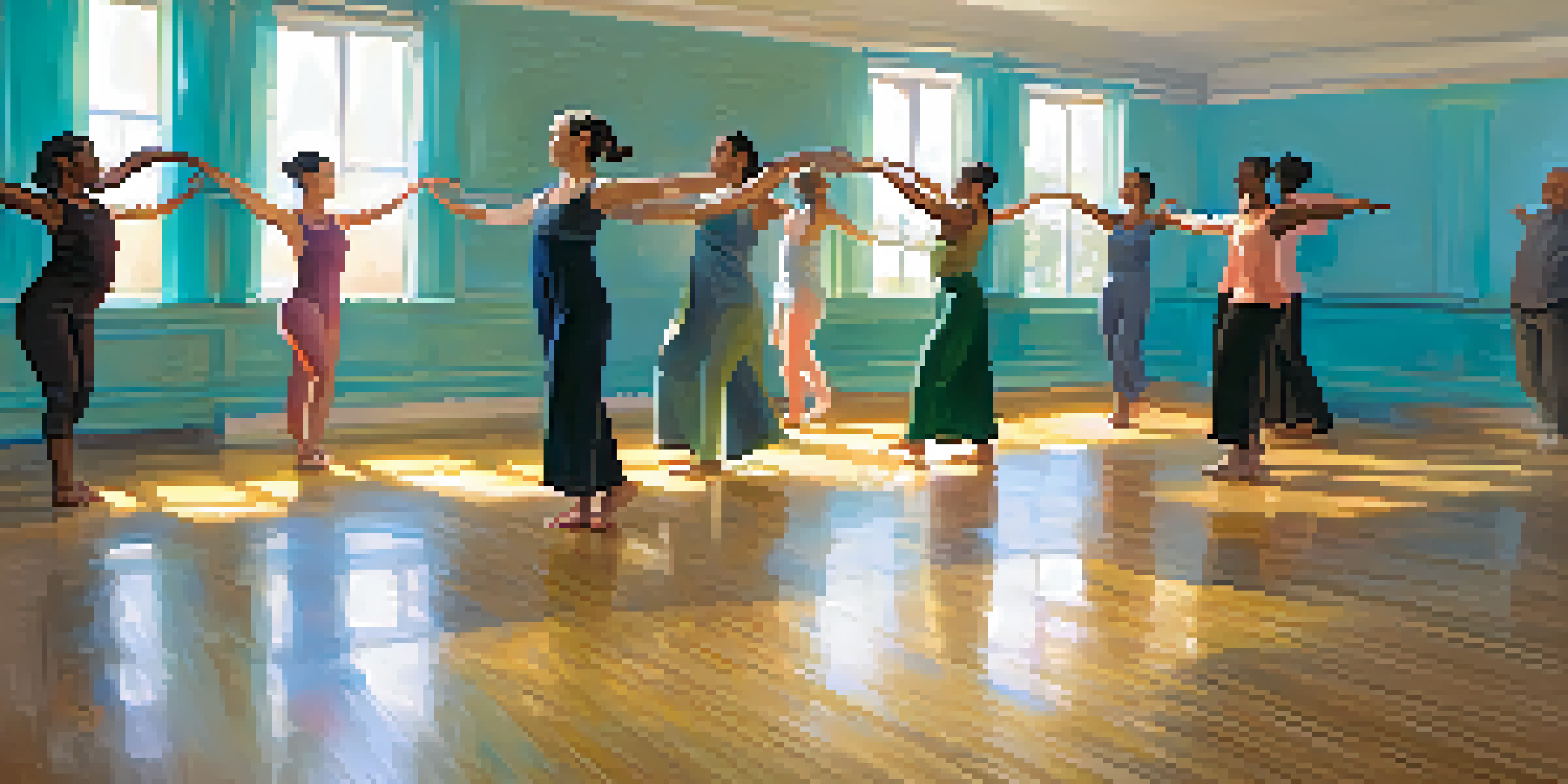The Therapeutic Benefits of Dance Movement Therapy

Understanding Dance Movement Therapy: An Overview
Dance Movement Therapy (DMT) is a therapeutic approach that uses dance and movement to support emotional, cognitive, and physical well-being. It allows individuals to express themselves through body language, which can be especially powerful for those who find verbal communication challenging. By engaging in this form of therapy, participants can tap into their emotions in a safe and supportive environment.
Dance is the hidden language of the soul.
At its core, DMT combines elements of psychology, dance, and movement science to facilitate healing. This innovative approach recognizes the mind-body connection, where physical movement can lead to emotional release and healing. Whether it's through simple gestures or complex choreography, the act of moving can evoke powerful feelings and insights.
DMT is practiced in various settings, including hospitals, schools, and private practices, making it accessible to a wide range of individuals. From children with developmental challenges to adults dealing with trauma, this form of therapy adapts to meet the unique needs of each participant. It’s not just about dancing; it’s about finding a voice through movement.
The Emotional Benefits of Dance Movement Therapy
One of the most profound benefits of DMT is its ability to help individuals process emotions. Dance can serve as a non-verbal outlet for feelings that might be difficult to articulate. For instance, someone grappling with grief might find solace in moving their body, allowing them to express sorrow in a way that words cannot capture.

Participants often report a sense of liberation and relief after engaging in DMT sessions. The act of moving rhythmically can shift emotional states, promoting feelings of joy and connection. This is particularly beneficial for those who struggle with anxiety and depression, as movement helps to release endorphins, the body’s natural mood enhancers.
Emotional Healing Through Movement
Dance Movement Therapy offers a unique way for individuals to process emotions non-verbally, fostering self-awareness and emotional regulation.
Moreover, DMT fosters self-awareness and mindfulness. As individuals become more attuned to their bodies, they begin to recognize emotional patterns and responses. This heightened awareness can lead to greater emotional regulation and resilience, empowering individuals to navigate life’s challenges more effectively.
Physical Health Benefits of Dance Movement Therapy
Beyond emotional healing, DMT offers significant physical health benefits. Engaging in dance-like movements can improve flexibility, coordination, and strength. For people recovering from injuries or dealing with chronic pain, DMT provides a gentle yet effective way to regain mobility and enhance physical well-being.
The body says what words cannot.
Dance movement therapy can also promote cardiovascular health. As participants engage in rhythmic movement, their heart rates increase, providing an aerobic workout that benefits overall fitness. Just think of it as a fun way to stay active without the monotony of traditional exercise routines.
Additionally, DMT helps in reducing stress and tension in the body. The rhythmic and flowing movements encourage relaxation, which can alleviate muscle tightness and improve posture. This holistic approach to physical health complements traditional therapies and can lead to a more balanced lifestyle.
Enhancing Social Connections Through Movement
Dance Movement Therapy is not just an individual practice; it can also foster social connections. Group sessions create a sense of community and belonging among participants, allowing them to share experiences and support one another. This social aspect can be particularly healing for those feeling isolated or lonely.
Working in a group setting encourages teamwork and communication. Participants may engage in partner dances or group improvisation, which cultivates trust and mutual respect. These interactions can enhance interpersonal skills and create lasting friendships, contributing to a stronger support network.
Physical Benefits of DMT
Engaging in Dance Movement Therapy can enhance physical health by improving flexibility, coordination, and cardiovascular fitness.
Moreover, the shared experience of movement can break down barriers. People from diverse backgrounds come together to connect through dance, highlighting our common humanity. This sense of unity is a powerful antidote to feelings of alienation.
Dance Movement Therapy for Trauma Recovery
DMT has shown remarkable effectiveness in helping individuals recover from trauma. Traditional talk therapies may not always resonate with those who have experienced significant emotional upheaval. Movement offers an alternative way to process trauma, allowing the body to release pent-up emotions without directly confronting painful memories.
Through specific movements, participants can begin to reclaim their bodies and establish a sense of safety. For example, grounding movements can help individuals feel more connected to the present moment, reducing anxiety related to past experiences. This can be particularly beneficial for survivors of abuse or those coping with PTSD.
Additionally, DMT provides a space for empowerment. As participants learn to express themselves through movement, they often discover their strength and resilience. This newfound confidence is a crucial step in the healing journey, enabling individuals to move forward with their lives.
The Role of a Dance Movement Therapist
A Dance Movement Therapist plays a crucial role in guiding participants through their therapeutic journey. They are trained to observe and interpret movement patterns, using this insight to inform their therapeutic interventions. This expertise helps create a safe environment where individuals can explore their emotions freely.
Therapists often tailor sessions to meet the specific needs of each participant. Whether it's through structured exercises or spontaneous improvisation, they adapt their approach to facilitate personal growth. This individualized attention is key to the effectiveness of DMT as a therapeutic practice.
Building Connections in Group Therapy
DMT promotes social connections and teamwork, creating a sense of community among participants and enhancing interpersonal skills.
Furthermore, therapists foster a sense of trust and rapport, which is essential for healing. By creating a supportive atmosphere, they encourage participants to take emotional risks through movement. This nurturing relationship is often a transformative aspect of the DMT experience.
Getting Started with Dance Movement Therapy
If you’re interested in exploring Dance Movement Therapy, the first step is to find a qualified therapist. Look for practitioners who are certified and have experience in various therapeutic settings. Many therapists offer introductory sessions, which can help you gauge if this approach resonates with you.
It’s important to remember that DMT is for everyone, regardless of age or physical ability. Whether you’re a seasoned dancer or have never danced before, the focus is on personal expression rather than skill. The goal is to connect with your body and emotions in a way that feels authentic to you.

Finally, be open to the experience. DMT can be a journey of self-discovery, so approach it with curiosity and a willingness to explore. The therapeutic benefits of movement can be profound, offering a unique pathway to healing and personal growth.